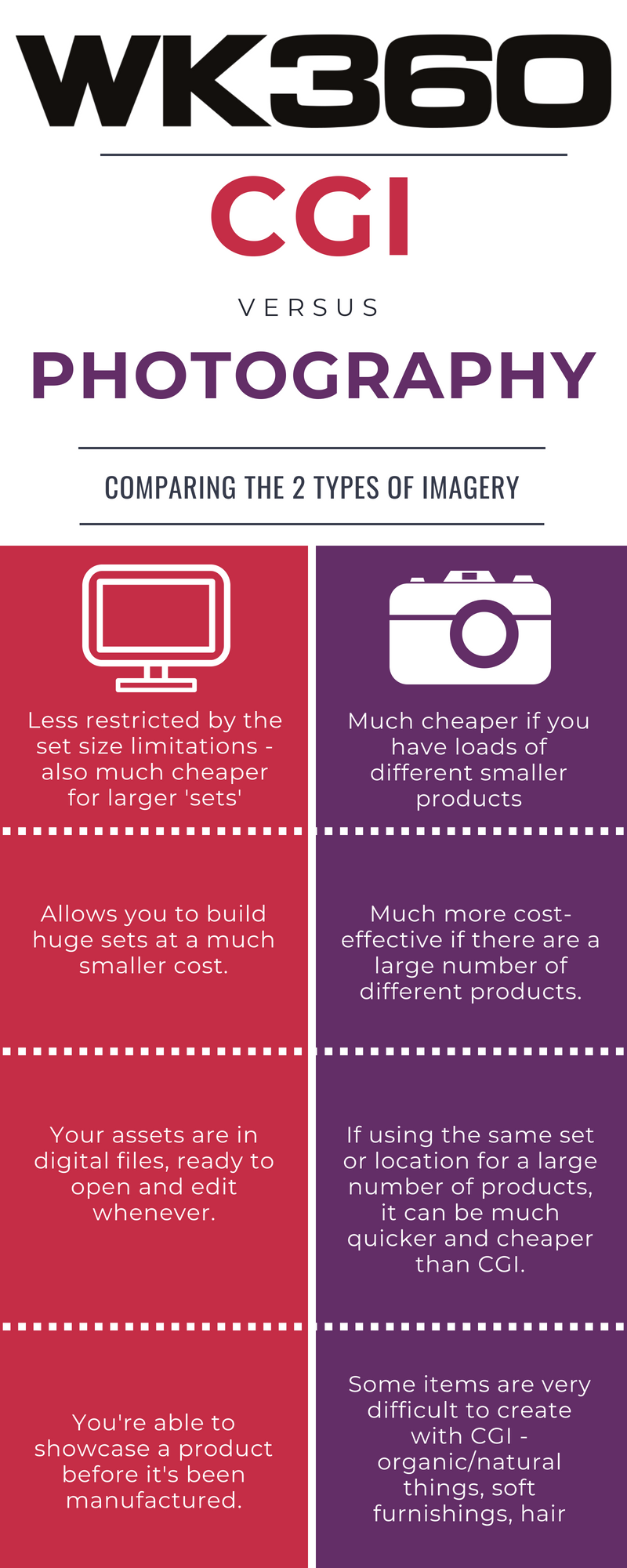Traditional Photography vs Computer Generated Imagery
The premise
Let’s say you want to buy a pair of shoes online. You find your favourite brand and look for a bargain. After making your choice, you realise this shoe is customisable – there are five colours to choose from! There are three different types of laces! And – oops – you click off the children’s size and type in your actual size.
With all these options to choose from, online retail’s latest growing trend is to allow consumers to see all the different configurations available for a product. Customers are not satisfied with just a fabric swatch. They need to see the product in the precise material/colour/size they plan to purchase.
CGI vs photography
CGI is by far the most cost-effective way to do this. Creating a computer generated model of a product gives you a complete record of it – this could be delivered in all kinds of angles, colours and textures, and without any design or size restrictions. While no one in their right mind would dismiss traditional photography (it still has a big place in modern e-commerce), it would simply cost too much time, effort, and money to produce.
Creating something using CGI means you will always have access to the digital file. This means you are able to access it whenever you like, allowing you to change any style elements, products or moods without having to re-shoot.
CGI product imagery is now almost impossible to be distinguished from a genuine photograph. It allows companies to showcase their products in every size/colour/angle/texture before they even manufacture it. And, most importantly, it is cheaper than ever before.
Before CGI, we provided room-set shots exclusively by building physical room-sets and shooting them using traditional photography. As technology has improved - and our experts with it - we have been able to provide high quality, convincing CGI, faster, at a lower cost and with more flexibility for future use.
It is now very difficult to distinguish between the two. Of the two images below, one was created with CGI and the other, traditional photography. Can you tell which is which?
Spoiler alert:
If you said the first image was CGI, you’d be right! To the eyes of an every-day shopper, there is no difference – only a seasoned designer would be able to spot the difference without a thorough inspection.
Our CGI specialists have a keen eye for detail, and will never miss even the smallest shadow or light reflection. What’s more, we would be able to change anything about the image – if our client wanted a different flooring, we would change it. Different lighting? No problem. If they wanted a different angle, that would take seconds – rather than a whole day to set up the room-set again and reshoot.
Mixing the two together
Of course, photography is still undeniably important in e-commerce. It’s much cheaper to book a day in the studio for product photography, rather than creating a 3D model for each of your 200 products from scratch. And, cost-efficiency aside, people will always prefer something real if they can get it.
There are still a few issues with CGI that stop it from dominating. Some items, such as trees, animals and other organic things, just don’t look right when they’re computer generated. The 3D rendering would take too long to be cost-efficient. The best solution to this would be to merge the two imagery mediums together.
Many e-commerce images (including our own) now consist of both CGI and traditional photography. For the sake of authenticity, we would photograph the product, then render CGI over it, wiping out any imperfections, and adding textures, colours or even movement. This is the best of both worlds – and, unlike Hannah Montana, it will be trending for a long time to come.
Here’s an infographic we created, detailing the advantages/disadvantages of using CGI or photography.
Companies that use a mixture of CGI and photographic imagery will unleash their full merchandising potential. They both currently have their own strengths and weaknesses, and often enough the final decision will come down to cost. But there’s no doubt that CGI has quickly become an integral part of modern e-commerce.
If you have any enquiries about CGI or photography, get in touch with us at WK360 – our imagery experts relish any opportunity to get creative. ~ hello@wk360.com
Written by John Davis



